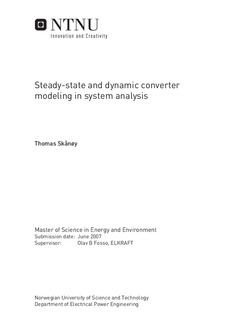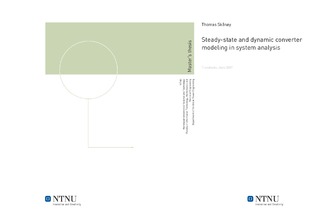| dc.description.abstract | This master thesis was executed at the Department of Electrical Power Engineering at the Norwegian University of Science and Technology (NTNU). The thesis was initiated to establish and evaluate an alternative model representation of the facility at Ormen Lange. Traditionally, a PQ-model has been used to represent Ormen Lange. This thesis, however, has implemented three two-terminal dc line models (converter models) to represent the facility. The first part of the thesis starts with an overall introduction to the basic principles of configuration, operation and control of HVDC systems. The objective of this part is to provide an overview of the HVDC technology which is treated in detail later in the thesis. The software tool Power System Simulator for Engineering (PSS/E) was used for both power flow and dynamic simulations performed in this thesis. The second part of the thesis describes the power flow establishment, and constitutes the basis for both power flow and dynamic simulations. The main focus in this part is the modeling of the two-terminal dc line model which is implemented at Nyhamna. Data for the two-terminal dc line model is presented on three consecutive data records. Since these data enables not only power flow analysis but also establishes the initial steady-state for the dynamic analysis, a detailed description is presented in this section. The latter data is based on technical information provided by ABB and default values in PSS/E. The third part of the thesis presents the power flow simulations. The objective of this part is to gain knowledge about the performance of the two-terminal dc line model implemented at Ormen Lange. This knowledge facilitates the understanding of the following dynamic simulations. Two cases were studied to simulate the action of the converter control system when exposed to a depression in rectifier bus voltage. In the first case the rectifier transformer tap settings were adjustable. In the second case the rectifier tap settings were locked to its initial value. The purpose of locking the tap setting was to represent a transient situation where the tap changer action is too slow and hence not considered. The result showed that with adjustable rectifier tap settings, the depression in rectifier bus voltage is handled by reducing the rectifier transformer tap position and firing delay angle. This increased the voltage on the valve side of the rectifier transformer and enabled the rectifier to maintain dc current control. Consequently, the scheduled dc values were unaffected by the depression in rectifier bus voltage. However, with the rectifier tap setting locked, the transformer did not boost the voltage on the valve side of the rectifier transformer. This caused the control logic to reduce the rectifier firing delay angle to its minimum, and the inverter assumed control of the dc current. With the inverter in control of the current, the scheduled dc current was reduced by a fraction equal to the current margin along with the remainder dc values. Hence, the presence of an adequate rectifier transformer setting is essential for the two-terminal dc line model to maintain scheduled dc values during voltage depression. All simulations showed that a voltage depression at the rectifier bus leads to a reduction in rectifier reactive power consumption. This is due to the action from the control logic which reduced the rectifier firing delay angle to counteract the voltage depression. The greatest reduction in rectifier reactive consumption was experienced when the rectifier firing delay angle was reduced to its minimum value. Hence, in situations with depressed bus voltage, the latter operation of the converter control logic causes the two-terminal dc line model to exhibit less stress to the ac system than the PQ-model. The fourth part of this thesis contains a detailed description of the dynamic modeling of the two-terminal dc line model (CDC4T). Many of the chosen parameters are based on an example in [15], and do not necessary represent realistic values. The final part of this thesis presents the dynamic simulations. The objective of this part is to analyze the control actions of the CDC4T model under normal regulation and during temporary overriding the normal regulation. This was performed by introducing ac system faults which depressed the rectifier bus voltage to a varying degree. Further, this part analyzed the consequence of using the dynamic model CDC4T to represent Ormen Lange instead of a PQ-model. The purpose was to determine whether the response from the ac system differs when using the CDC4T model instead of a PQ-model. It is important to emphasize that this part does not evaluate stability issues associated with the implementation of CDC4T. The results from the dynamic simulations showed that CDC4T exhibited an instantaneous response to changes in rectifier ac voltage. This is because CDC4T is a pseudo steady-state dynamic model which omits the L/R dynamic of the dc system and high frequency firing angle controller dynamics. Further, the results revealed an important characteristic of the CDC4T model. After fault clearance, the rectifier bus exhibited small voltage fluctuations. The rectifiers compensated these fluctuations by adjusting their firing delay angles correspondingly. Consequently, the latter resulted in fluctuations in reactive power consumption. This means that the ac system perceives the CDC4T model as a varying reactive load following fault clearance. Comparing the ac system response when using the CDC4T model and when using the PQ-model, the results showed that the main difference was CDC4T s generation of reactive power fluctuations. These fluctuations were experienced in the transmission line going into Nyhamna and Viklandet, and were substantial compared to the initial loading of the transmission lines. Two arguments were used to substantiate why the response from the CDC4T model only differs from the PQ-model in terms of reactive power fluctuations: I. The calculated value of the short circuit ratio at Nyhamna indicated a strong interconnected ac/dc system. II. The dynamic behavior of the pseudo-steady state model, CDC4T, is limited. Both the L/R dynamic of the dc line, smoothing reactors and high frequency controller dynamics are omitted. In further studies where converter modeling at Ormen Lange is considered, a more complex dynamic dc model should be utilized to represent the converters. This model should include L/R dynamic of the dc system and high-speed controller dynamics, and will thus influence the ac system to a greater extent than CDC4T. Further, the model establishment should focus on achieving a sufficiently realistic load representation of Ormen Lange. In this manner, the converters influence on system stability can be evaluated. | nb_NO |

